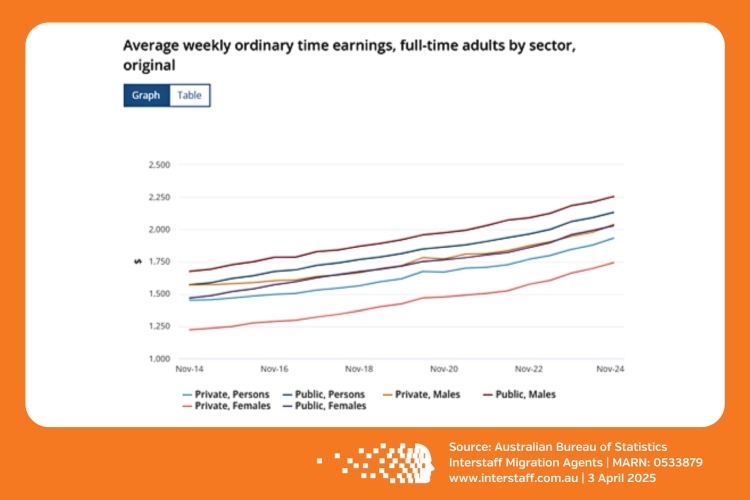- within Immigration topic(s)
- with Senior Company Executives, HR and Finance and Tax Executives
- in United States
- with readers working within the Banking & Credit, Retail & Leisure and Construction & Engineering industries
- within Immigration topic(s)
- with Senior Company Executives, HR and Inhouse Counsel
- in United States
- with readers working within the Basic Industries, Media & Information and Retail & Leisure industries
From 1 July 2025, a 4.6% increase in Skilled Visa Salary Thresholds will apply, requiring employers to offer higher salaries to employees they nominate for Subclass 482, 494 and 186 Visas from this date.
The change reflects the Government's commitment to annually adjust salary thresholds on 1 July in line with increases to the Average Weekly Ordinary Time Earnings (AWOTE) so that wages for migrants rise at the same rate as Australian workers.
Recent legislative changes also now require Salary Thresholds for 482 Visas to be met via monetary earnings only.
Here's our insights on:
- New Salary Thresholds from 1 July 2025 for the:
-
- Core Skills Income Threshold (CSIT)
- Specialist Skills Income Threshold (SSIT)
- Temporary Skilled Migration Income Threshold (TSMIT)
- What businesses should do now to plan for the change.
The New CSIT, SSIT and TSMIT | Salary Indexation From 1 July 2025
Businesses will need to pay new applicants for 482, 494 and 186 Visas at least the new Salary Threshold or the Annual Market Salary Rate (whichever is higher).

How Businesses Should Plan Now
Here are 6 ways that businesses can prepare for the changes now:
1. Plan and provide offers of employment that meet the new Salary Thresholds for new Subclass 482, 494 and 186 Visa applications.
2. Consider options for applicants that are on the cusp of the new salary threshold for the 482 Visa Specialist Skills Stream ($141,210 from 1 July 2025). They may be able to apply for the 482 Visa under the Core Skills Stream with lower salary requirements if their occupation is listed on the Core Skills Occupation List.
3. Consider whether the salary ranges advertised as part of your LMT (Labour Market Testing) can accommodate the Salary Thresholds required for new nominations after 1 July 2025.
4. Assess your business' requirements for visa renewals after 1 July 2025 and plan for a salary increase for applicants to stay for further work.
- For example, 482 Short Term Stream Visa holders within your business with a 1 or 2 year visa term that is due to expire.
5. Assess your business' requirements for PR through the 186 Visa.
- For example, current 482 Visa holders in your business that may be eligible for PR after 2 years of work in Australia.
6. Plan and budget for annual indexation of Salary Thresholds, which is set to occur on 1 July each year for new 482, 494 and 186 Visa applications.
The Salary Thresholds only apply to new applications for the 482, 494 and 186 Visas lodged from 1 July 2025. Existing visa holders in your business that do not require a new visa may not be impacted by the new Salary Thresholds until they need to renew their visa or apply for PR after this date.
Businesses should also ensure that the new Salary Threshold for 482 Visas is met via guaranteed monetary earnings only rather than other types of guaranteed earnings (such as accommodation expenses). A 482 Visa applicant's salary can still be comprised of non-monetary earnings, however these earnings cannot count towards meeting the Salary Threshold.
Interstaff | Strategic Immigration for Business

With Salary Thresholds increasing by almost 5% in the last two years, it has become more important for businesses to conduct a salary review and have an adjustment system in place for sponsored visa holders.
Should this threshold trend continue, we may see an increased reliance on the Core Skills Stream of the 482 Visa, which is limited to people with an occupation on the Core Skills Occupation List or DAMA and Labour Agreement streams.
If you have any questions and would like professional visa, sponsorship or migration advice, we encourage you to contact Interstaff's Registered Migration Agents.
You can also connect with us on LinkedIn to stay updated on Australian immigration news and developments.
Source:
Interstaff's Registered Migration
Agents
The Migration Institute of Australia
The Department of Home Affairs
The Australian Bureau of Statistics
The content of this article is intended to provide a general guide to the subject matter. Specialist advice should be sought about your specific circumstances.


